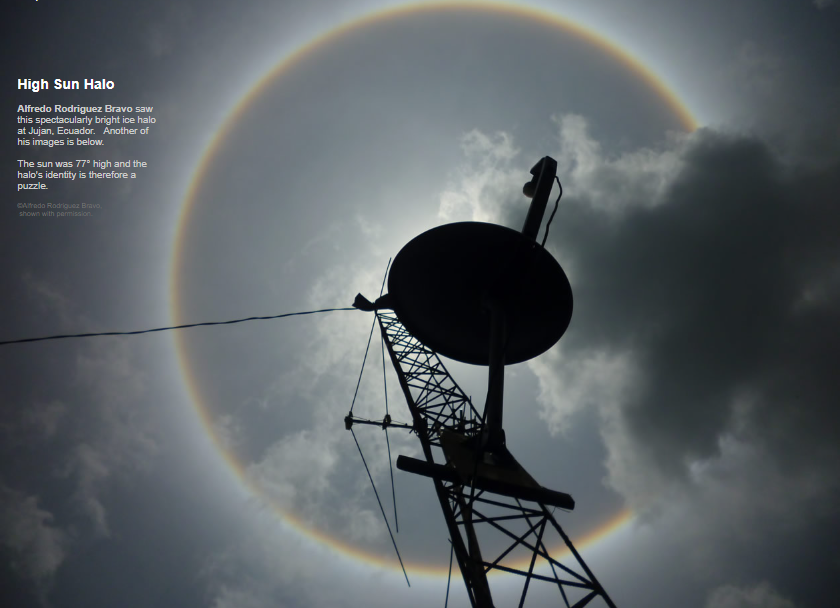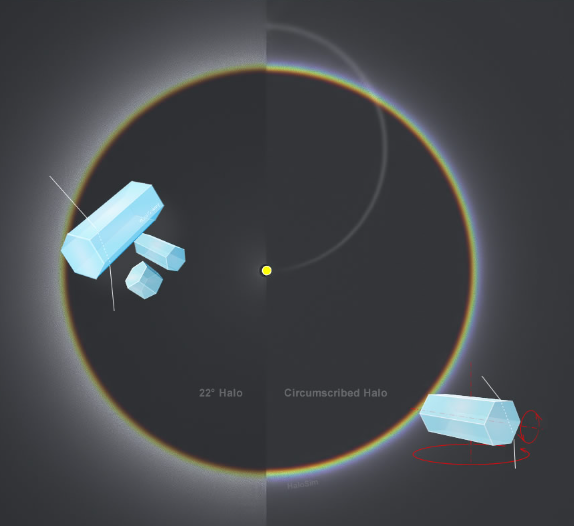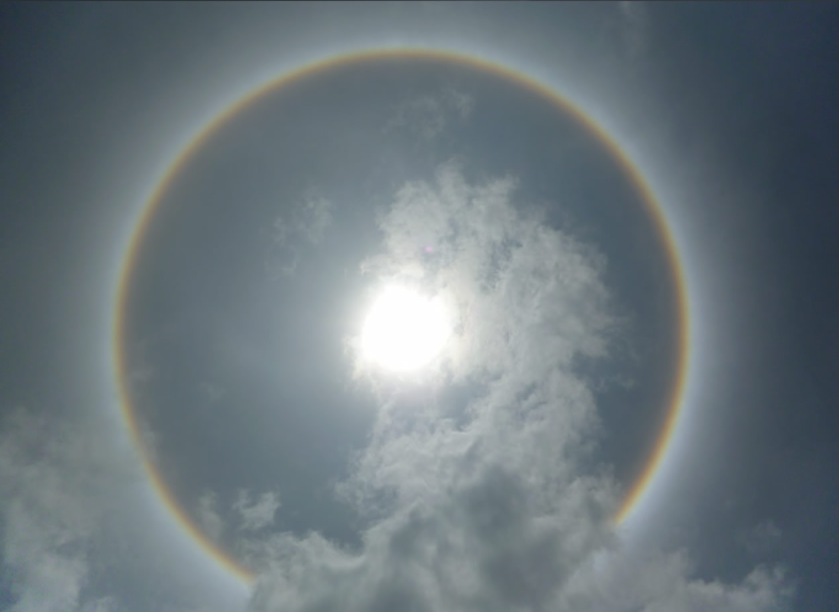OPOD - High Sun Halo
OPOD - High Sun Halo: Exploring the Spectacular Phenomenon
Have you ever witnessed a mesmerizing ice halo encircling the sun? Alfredo Rodriguez Bravo captured this breathtaking sight in Jujan, Ecuador. With the sun positioned at an impressive altitude of 77°, the identity of this halo becomes a fascinating puzzle. Let's delve into the world of atmospheric optics and unravel the mysteries behind this high sun halo.
A "circular" halo encompassing a high sun does not necessarily refer to the common 22° halo. Instead, it could be a circumscribed halo, which presents a different set of characteristics. The 22° halo is formed by randomly oriented hexagonal prisms, likely clustered together. This halo maintains its circular shape regardless of the sun's altitude. On the other hand, the circumscribed halo is generated by hexagonal prisms that are aerodynamically aligned with their long axes horizontal. These prisms, known as "singly oriented columns," produce the saggy oval shape when the sun is around 40° high, gradually transitioning into a circular shape as the sun ascends.
To distinguish between these two halos, we can examine their distinct features. The 22° halo exhibits diffuse colors with extensive brightness outside its main ring. In contrast, the circumscribed halo displays more saturated colors and its "white" intensity diminishes more rapidly beyond the colors. Interestingly, generating a simulation of the 22° halo requires three times as many crystals as the circumscribed halo, making it less efficient in terms of crystal usage.
While these differences are apparent in simulations, they may not be as pronounced when observed in the sky. Therefore, it is essential to search for additional clues to identify the type of halo present. One clue to consider is the presence of a bright upper tangent arc at a lower sun position. This indicates horizontal column crystals and suggests the occurrence of a circumscribed halo when the sun is high. Horizontal columns also produce a parhelic circle by reflecting light from their near-vertical hexagonal end faces.
Determining the type of halo captured by Alfredo Rodriguez Bravo requires careful analysis. Was there a bright upper tangent arc visible at a lower sun position? If so, it would indicate horizontal column crystals and suggest the presence of a circumscribed halo at high sun. However, it's important to note that plate crystals can also create a parhelic circle, making the identification more challenging.
In conclusion, the high sun halo is a captivating atmospheric optics phenomenon that can leave us in awe of nature's wonders. Understanding the distinctions between the 22° halo and the circumscribed halo allows us to appreciate their unique characteristics. By carefully observing additional clues, such as the presence of a bright upper tangent arc, we can gain further insights into the types of crystals involved in creating these remarkable halos. The world of atmospheric optics continues to surprise and inspire us, reminding us of the intricate beauty that exists above us in the sky.

High Sun Halo
Alfredo Rodriguez Bravo saw this spectacularly bright ice halo at Jujan, Ecuador. Another of his images is below.
The sun was 77° high and the halo's identity is therefore a puzzle.
©Alfredo Rodriguez Bravo,
shown with permission.

A �circular� halo around a high sun is not necessarily the common 22� halo. It could be a circumscribed halo.
Randomly oriented hexagonal prisms, probably in clusters, make the 22� halo. It is circular at all sun altitudes. Hexagonal prisms aerodynamically aligned with their long axes horizontal � �singly oriented columns, - generate the circumscribed halo. When the sun is 40� high or so the halo is a saggy oval. As the sun climbs it approaches a circular shape.
Both halos are side by side in the HaloSim ray tracings at right. The sun altitude was set to 77�.
The 22� halo has diffuse colours with extensive brightness outside the main ring. The circumscribed halo has more saturated colours and its �white� intensity beyond the colours falls off more quickly. The 22° halo is 'less efficient', three times as many crystals were needed to generate the simulation.
The differences are obvious when compared directly in the ideality of a simulation but they can be much less so in the sky. Search for other clues. Was there a bright upper tangent arc at lower sun? That would indicate horizontal column crystals and a circumscribed halo at high sun. Horizontal columns also produce a parhelic circle by glinting light from their near vertical hexagonal end faces. The right-hand ray tracing shows the diminutive PC when the sun is high. Its brightness depends on the crystals� aspect ratio, long crystals have a relatively smaller area of end faces and give a dimmer PC compared to the circumscribed halo. The end faces might be imperfect, they frequently are, and the PC is then weak or absent. And a PC is not definite proof of horizontal column crystals, plate crystals also make it.
What was Alfredo�s halo? You decide!

Note: this article has been automatically converted from the old site and may not appear as intended. You can find the original article here.
Reference Atmospheric Optics
If you use any of the definitions, information, or data presented on Atmospheric Optics, please copy the link or reference below to properly credit us as the reference source. Thank you!
-
<a href="https://atoptics.co.uk/blog/opod-high-sun-halo/">OPOD - High Sun Halo</a>
-
"OPOD - High Sun Halo". Atmospheric Optics. Accessed on April 20, 2024. https://atoptics.co.uk/blog/opod-high-sun-halo/.
-
"OPOD - High Sun Halo". Atmospheric Optics, https://atoptics.co.uk/blog/opod-high-sun-halo/. Accessed 20 April, 2024
-
OPOD - High Sun Halo. Atmospheric Optics. Retrieved from https://atoptics.co.uk/blog/opod-high-sun-halo/.